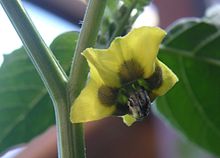- Tomatillo
-
Tomatillo 
Fresh harvest of German tomatillos Scientific classification Kingdom: Plantae (unranked): Angiosperms (unranked): Eudicots (unranked): Asterids Order: Solanales Family: Solanaceae Genus: Physalis Species: P. philadelphica Binomial name Physalis philadelphica
Lam. (1786)Synonyms Physalis ixocarpa Brot.
The tomatillo (Physalis philadelphica) is a plant of the nightshade family, related to the cape gooseberry, bearing small, spherical and green or green-purple fruit of the same name. Tomatillos are a staple in Mexican cuisine. Tomatillos are grown as annuals throughout the Western Hemisphere. Often self-incompatible, tomatillos need a second plant to enhance pollination and guarantee fruit set.[citation needed]
Contents
Description
The tomatillo fruit is surrounded by an inedible, paper-like husk formed from the calyx. As the fruit matures, it fills the husk and can split it open by harvest. The husk turns brown, and the fruit can be any of a number of colors when ripe, including yellow, red, green, or even purple. Tomatillos are the key ingredient in fresh and cooked Latin American green sauces. The freshness and greenness of the husk are quality criteria. Fruit should be firm and bright green, as the green color and tart flavor are the main culinary contributions of the fruit. Purple and red-ripening cultivars often have a slight sweetness, unlike the green- and yellow-ripening cultivars, and are therefore somewhat more suitable for fruit-like uses like jams and preserves. Like their close relatives cape gooseberries, tomatillos have a high pectin content. Another characteristic is they tend to have a varying degree of a sappy sticky coating, mostly when used on the green side out of the husk.
Tomatillo plants are highly self-incompatible (two or more plants are needed for proper pollination; thus isolated tomatillo plants rarely set fruit).
Ripe tomatillos will keep in the refrigerator for about two weeks. They will keep even longer if the husks are removed and the fruits are placed in sealed plastic bags stored in the refrigerator.[1] They may also be frozen whole or sliced.
Names
The tomatillo is also known as the husk tomato, jamberry, husk cherry, Mexican tomato, or ground cherry, but the latter is more appropriately used to describe the relative of which bears smaller fruit. These names can also refer to other species in the Physalis genus. In Spanish, it is called tomate de cáscara, tomate de fresadilla, tomate milpero, tomate verde (green tomato), tomatillo Mexico (this term means "little tomato" elsewhere), miltomate (Mexico, Guatemala), or simply tomate (in which case the tomato is called jitomate). Even though tomatillos are sometimes called "green tomatoes", they should not be confused with green, unripe tomatoes (tomatoes are in the same family, but a different genus). In Assamese it is called pokmou.
Image gallery
-

Green tomatillo fruits
See also
References
- ^ Carter, Noelle; Deane, Donna (2008-05-14). "Tomatillo: a green sourpuss with a sweet side". Los Angeles Times (Latimes.com). http://www.latimes.com/features/food/la-fo-tomatillo14-2008may14,0,1107342.story. Retrieved 2009-08-03.
External links
Wikimedia Foundation. 2010.


